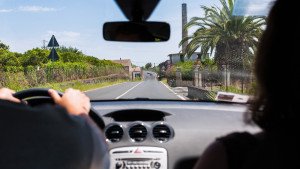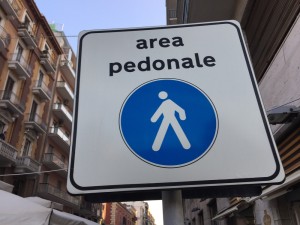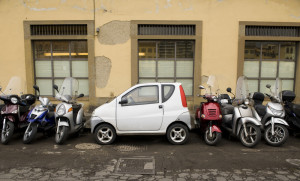Driving in Italy is unlike any other country you may have visited. Getting around in the city can be a thrilling and challenging experience, while the country roads are more relaxed and leisurely to drive. Italians drive on the right side of the road, but their laws may seem stricter than American traffic laws. Right turns during a red light are always illegal, and speed limits are controlled via automatic traffic cameras that tourists don’t see coming. Italian drivers have a unique set of customs and habits, but with a bit of preparation you can remain safe on the road as you see the best Italy has to offer.
 Italian Drivers
Italian Drivers
Driving in Italy is an aggressive, fast-paced activity in the cities, while the country is more laid back in some regards. Fast lane changes, tailgating, and braking as late as possible are to be expected on Italian streets. The best way to fit in is to be as assertive as possible, taking any small gap as an invitation to enter the lane. Honking horns and flashing headlights take on new meaning on Italian streets. A flashing light can act as a signal to move out of the way or as a warning of an upcoming traffic stop. Horns can be used to greet other drivers, alert them of danger, or prompt quick action at a stoplight, so expect to hear more honking than you might elsewhere. To drive in Italy, U.S. citizens will need to apply for an International Driving Permit (IDP) through AAA or acquire an official Italian translation of their U.S. license.
City Driving
City driving presents a unique set of challenges for the traveler. Cobblestone streets are common and provide for a bumpy ride that many Americans are not familiar with. Drivers in the city are assertive and pay no attention to those behind them. They drive close together, expecting all gaps in the road to be filled with cars. If you don’t fill these gaps, the locals will pass around you to fill them for you. Don’t take these actions personally, but get involved and embrace the driving culture. Parking can be difficult to find, but most cities have large parking lots just outside of city center so you should avoid parking on sidewalks. Gas can be difficult to find because most stations close for lunch between 12:30-3:00 pm, so plan ahead and get your petrol early in the day.
Off Limit Streets
The most common cause of visitors being fined is driving on restricted streets. Look out for signs designating a “zona traffico limitato” or “zona pedonale” as these streets are designed for pedestrian use only. Pay attention to signs and the direction of traffic within the city to avoid going the wrong direction on a one-way street.
Italy’s Country Roads
Country driving is more relaxed than city driving. Two-lane highways are common with speed limits that vary but are strictly enforced. Be aware of the level of gas in your tank while driving in the country, and stop in larger towns to buy petrol before you start to run out. Planning ahead allows you to take in the gorgeous landscapes including mountains, small farms and vineyards, and ocean views.
Types of Vehicles to Expect
Most vehicles in Italy are much smaller than American cars, and the majority have a manual transmission. Scooters or Vespas are common, especially in cities where they can be seen weaving around slower car traffic.
Driving in Italy can be a daunting task, but with the right knowledge and a bit of bravery, you can enjoy a leisurely tour of the country at your own pace. Remember to follow the speed limit even when you don’t see police officers; you often won’t know you’ve gotten a ticket until it gets charged to your credit card by your car rental agency. Don’t be thrown off by the assertive driving around you! Do your best to keep up, and remember to take breaks often to enjoy the scenery and culture of the land around you.

